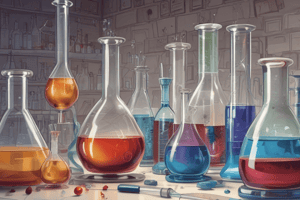Podcast
Questions and Answers
Which of the following is NOT a type of laboratory glassware?
Which of the following is NOT a type of laboratory glassware?
- Graduated cylinder
- Beaker
- Fork (correct)
- Test tube
What does pH measure?
What does pH measure?
- The volume of a liquid
- The weight of a solid
- The temperature of a solution
- The hydrogen ion concentration (correct)
A solution with a pH less than 7 is considered neutral.
A solution with a pH less than 7 is considered neutral.
False (B)
What is the formula for calculating pH?
What is the formula for calculating pH?
What is the range of pH values?
What is the range of pH values?
Who proposed the Bronsted-Lowry theory?
Who proposed the Bronsted-Lowry theory?
Acids are substances that can donate a ______ ion.
Acids are substances that can donate a ______ ion.
Bases are substances that accept ______ ions.
Bases are substances that accept ______ ions.
Define potential of hydroxide (pOH).
Define potential of hydroxide (pOH).
Flashcards are hidden until you start studying
Study Notes
Laboratory Glasswares
- Essential for performing biochemical analyses with specific functions in the laboratory.
- Key glassware types include graduated cylinders, beakers, Erlenmeyer flasks, test tubes, crucibles, and more.
- Devices like spectrophotometers, analytical balances, and micropipettes aid in experiments.
- Common lab functions: measuring solutions, holding reagents, facilitating chemical reactions, and heating.
pH and Its Importance
- pH measures the acidity or basicity of a solution, with a scale ranging from 0 to 14.
- Acidic solutions have pH < 7, neutral solutions have pH = 7, and basic solutions have pH > 7.
- Hydrogen ion (H+) concentration directly affects biochemical reactions in living organisms.
Definition of pOH
- pOH measures hydroxide ion (OH-) concentration and is represented as the negative logarithm of [OH-].
- The relationship between pH and pOH allows for a comprehensive understanding of solution properties.
Definitions of Acids and Bases
- Svante Arrhenius: Acids produce H+ ions in an aqueous solution; bases produce OH- ions.
- Gilbert N. Lewis: Acids are electron-pair acceptors, while bases are electron-pair donors.
- Bronsted-Lowry Theory: A more widely accepted definition where acids are proton donors and bases are proton acceptors.
Reaction Between HCl and Water
- Not explicitly detailed, but implies that the reaction demonstrates the transfer of protons, relevant to understanding acidity.
Role of Buffers
- Buffers help maintain stable pH levels in biological systems, supporting homeostasis in organisms.
Studying That Suits You
Use AI to generate personalized quizzes and flashcards to suit your learning preferences.




